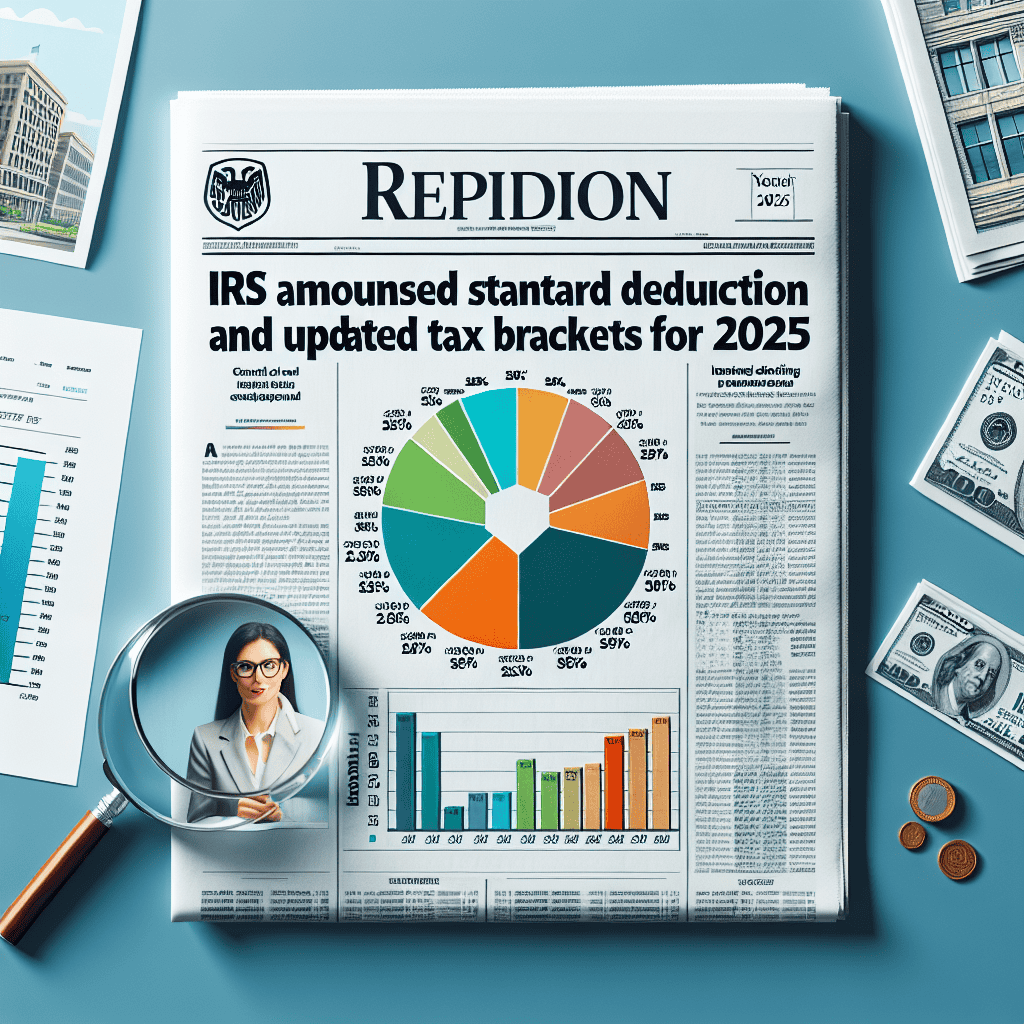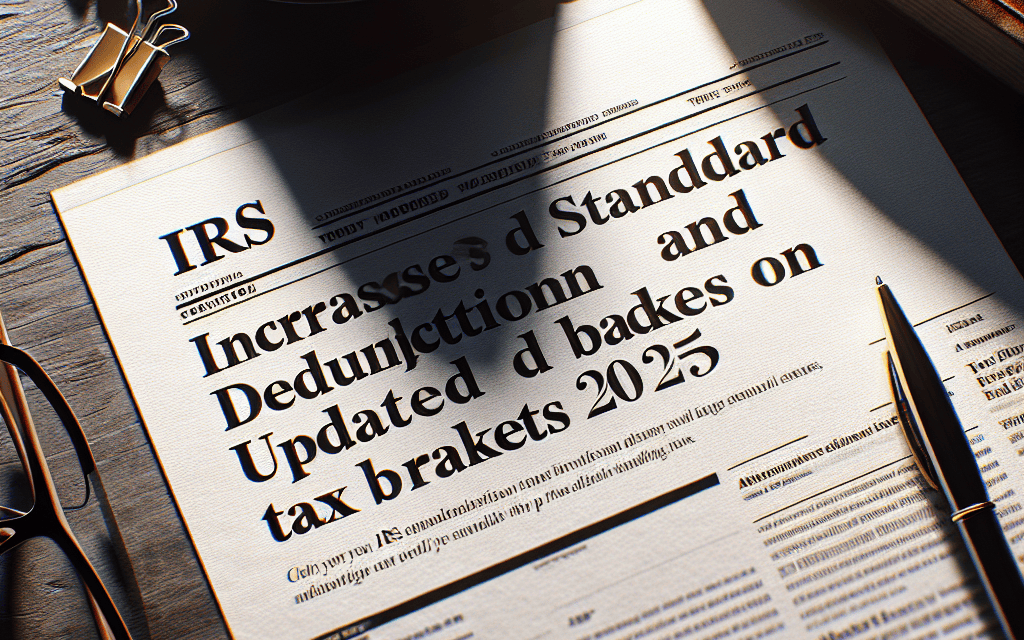“Maximize Your Refund: Discover the 2025 Tax Updates with Increased Deductions and New Brackets!”
Introduction
In a recent announcement, the Internal Revenue Service (IRS) has unveiled significant updates to the tax code for the year 2025, including an increase in the standard deduction and adjustments to the tax brackets. These changes are part of the IRS’s annual inflation adjustments, aimed at reflecting the economic shifts and ensuring taxpayers are not unduly burdened by inflation. The increased standard deduction is expected to provide relief to a broad spectrum of taxpayers, allowing them to reduce their taxable income more substantially. Additionally, the updated tax brackets will adjust the income thresholds for each tax rate, potentially altering the tax liabilities for many individuals and families. These modifications are designed to maintain fairness and accuracy in the tax system, aligning it more closely with current economic conditions. Taxpayers are encouraged to review these changes carefully to understand their potential impact on their financial planning and tax obligations for the upcoming year.
Understanding the 2025 Standard Deduction Increase: What It Means for Taxpayers
The Internal Revenue Service (IRS) has recently announced significant updates to the standard deduction and tax brackets for the year 2025, a move that is poised to impact millions of taxpayers across the United States. As these changes come into effect, it is crucial for taxpayers to understand what these adjustments entail and how they might influence individual and household tax liabilities. The increase in the standard deduction is particularly noteworthy, as it directly affects the amount of income that is not subject to federal income tax, thereby potentially reducing the overall tax burden for many.
To begin with, the standard deduction is a fixed dollar amount that reduces the income on which you are taxed, and it varies depending on your filing status. For 2025, the IRS has increased the standard deduction to reflect inflation and other economic factors. This adjustment means that taxpayers will be able to shield a larger portion of their income from taxation, which can be especially beneficial for those who do not itemize deductions. For instance, single filers will see an increase in their standard deduction, while married couples filing jointly will also benefit from a higher deduction threshold. This change is designed to simplify the tax filing process and provide relief to taxpayers by reducing their taxable income.
Moreover, the updated tax brackets for 2025 are another critical aspect of the IRS’s announcement. Tax brackets determine the rate at which income is taxed, and they are adjusted periodically to account for inflation. The new brackets for 2025 will see slight increases in the income thresholds, which means that taxpayers may find themselves in a lower tax bracket compared to previous years, depending on their income level. This adjustment is intended to prevent “bracket creep,” a situation where inflation pushes taxpayers into higher tax brackets, resulting in increased tax liabilities despite no real increase in purchasing power.
In addition to these changes, it is important for taxpayers to consider how the increased standard deduction and updated tax brackets might interact with other aspects of their financial situation. For example, those who typically itemize deductions may need to reassess whether it is still beneficial to do so, given the higher standard deduction. Furthermore, taxpayers should be aware of how these changes might affect their eligibility for certain tax credits and deductions, as well as their overall tax planning strategies.
As taxpayers prepare for the 2025 tax year, it is advisable to review these changes in detail and consider consulting with a tax professional to fully understand their implications. By doing so, individuals and families can make informed decisions about their tax filings and potentially optimize their tax outcomes. Additionally, staying informed about these updates can help taxpayers avoid surprises when it comes time to file their returns.
In conclusion, the IRS’s announcement of an increased standard deduction and updated tax brackets for 2025 represents a significant development in the realm of federal taxation. These changes are designed to provide relief to taxpayers by reducing taxable income and adjusting tax rates to better reflect current economic conditions. As such, it is essential for taxpayers to familiarize themselves with these updates and consider how they might impact their financial planning and tax strategies moving forward. By taking proactive steps to understand and adapt to these changes, taxpayers can better navigate the complexities of the tax system and potentially enhance their financial well-being.
How the Updated 2025 Tax Brackets Could Affect Your Tax Bill
The Internal Revenue Service (IRS) has recently announced significant updates to the standard deduction and tax brackets for the year 2025, changes that could have a notable impact on taxpayers across the United States. As these adjustments come into effect, it is crucial for individuals and families to understand how these modifications might influence their tax liabilities. The IRS’s decision to increase the standard deduction and adjust the tax brackets is primarily aimed at accounting for inflation and ensuring that taxpayers are not unduly burdened by rising costs of living.
To begin with, the standard deduction, which reduces the amount of income subject to tax, has been increased for all filing statuses. For single filers, the standard deduction will rise to $15,000, up from $13,850 in 2024. Married couples filing jointly will see their standard deduction increase to $30,000, compared to $27,700 in the previous year. This adjustment is expected to simplify the tax filing process for many, as more taxpayers may find it beneficial to take the standard deduction rather than itemizing deductions. Consequently, this could lead to a reduction in taxable income for a significant portion of the population, potentially lowering their overall tax bills.
In addition to the changes in the standard deduction, the IRS has also updated the tax brackets for 2025. These adjustments are designed to prevent “bracket creep,” a situation where inflation pushes taxpayers into higher tax brackets, resulting in increased tax liabilities despite no real increase in purchasing power. The new tax brackets will see slight increases in the income thresholds for each bracket, which means that more of a taxpayer’s income could be taxed at lower rates. For instance, the 10% tax bracket will now apply to income up to $11,500 for single filers and $23,000 for married couples filing jointly, compared to $11,000 and $22,000, respectively, in 2024.
As taxpayers assess how these changes might affect their tax bills, it is important to consider the broader implications. For many, the combination of a higher standard deduction and adjusted tax brackets could result in a lower effective tax rate, thereby increasing disposable income. This could provide some relief amid ongoing economic uncertainties and rising living costs. However, it is also essential to recognize that these changes may not benefit everyone equally. Taxpayers with higher incomes or those who typically itemize deductions may not experience the same level of tax savings.
Moreover, these updates underscore the importance of proactive tax planning. Individuals and families should consider reviewing their financial situations and consulting with tax professionals to optimize their tax strategies in light of the new regulations. By doing so, they can ensure that they are taking full advantage of the available deductions and credits, thereby minimizing their tax liabilities.
In conclusion, the IRS’s announcement of increased standard deductions and updated tax brackets for 2025 represents a significant development in the realm of personal finance. While these changes are designed to mitigate the effects of inflation and provide relief to taxpayers, their impact will vary depending on individual circumstances. As such, it is imperative for taxpayers to stay informed and engage in thoughtful tax planning to navigate the evolving tax landscape effectively.
Strategies to Maximize Benefits from the 2025 Standard Deduction Changes
The recent announcement by the IRS regarding the increased standard deduction and updated tax brackets for 2025 presents taxpayers with a unique opportunity to reassess their financial strategies. As these changes come into effect, it is crucial for individuals and families to understand how they can maximize the benefits from these adjustments. By strategically planning their finances, taxpayers can potentially reduce their taxable income and enhance their overall financial well-being.
To begin with, the increased standard deduction means that more income will be shielded from taxation, which is particularly beneficial for those who do not itemize deductions. For 2025, the standard deduction has been raised significantly, allowing taxpayers to deduct a larger portion of their income before calculating their tax liability. This change is especially advantageous for middle-income earners who may find that the increased deduction amount exceeds their itemized deductions, thus simplifying the filing process and potentially lowering their tax bill.
In light of these changes, one effective strategy is to evaluate whether itemizing deductions still makes sense. Taxpayers should compare the total of their potential itemized deductions, such as mortgage interest, state and local taxes, and charitable contributions, against the new standard deduction. If the standard deduction is higher, it may be more beneficial to opt for it, thereby streamlining the tax filing process and possibly reducing the risk of errors.
Moreover, the updated tax brackets for 2025 offer another avenue for strategic financial planning. With the IRS adjusting the income thresholds for each tax bracket, taxpayers may find themselves in a lower bracket, resulting in a reduced marginal tax rate. This shift can lead to significant tax savings, especially for those on the cusp of a higher bracket. To capitalize on this, individuals should consider strategies such as income deferral or accelerating deductions to ensure they remain in the most favorable tax bracket possible.
Additionally, taxpayers should explore opportunities for tax-advantaged savings. Contributing to retirement accounts like 401(k)s or IRAs can further reduce taxable income, as these contributions are often tax-deductible. By maximizing contributions to these accounts, individuals not only lower their current tax liability but also invest in their future financial security. Furthermore, health savings accounts (HSAs) offer another tax-efficient way to save, as contributions are tax-deductible, and withdrawals for qualified medical expenses are tax-free.
Charitable giving is another area where taxpayers can benefit from the updated tax landscape. With the increased standard deduction, it may be advantageous to bunch charitable contributions into a single tax year to exceed the standard deduction threshold and itemize deductions. This strategy allows taxpayers to maximize their charitable impact while also optimizing their tax situation.
In conclusion, the IRS’s announcement of increased standard deductions and updated tax brackets for 2025 provides taxpayers with a valuable opportunity to reassess and optimize their financial strategies. By carefully evaluating whether to itemize deductions, taking advantage of tax-advantaged savings accounts, and strategically planning charitable contributions, individuals can effectively reduce their taxable income and enhance their financial well-being. As these changes take effect, it is advisable for taxpayers to consult with financial advisors or tax professionals to ensure they are making the most informed decisions and fully capitalizing on the benefits available to them.
Comparing 2024 and 2025 Tax Brackets: Key Differences and Implications

The Internal Revenue Service (IRS) has recently announced significant updates to the standard deduction and tax brackets for the year 2025, marking a notable shift from the 2024 tax landscape. These changes are poised to impact taxpayers across various income levels, and understanding the key differences between the 2024 and 2025 tax brackets is crucial for effective financial planning. As we delve into these updates, it is essential to consider the broader implications they may have on individual taxpayers and the economy as a whole.
To begin with, the most prominent change is the increase in the standard deduction. For 2025, the IRS has raised the standard deduction to accommodate inflation and the rising cost of living. This adjustment is expected to provide relief to taxpayers by reducing their taxable income, thereby potentially lowering their overall tax liability. In comparison to 2024, where the standard deduction was set at a lower threshold, the 2025 increase represents a strategic move to align tax policy with economic realities. Consequently, taxpayers who opt for the standard deduction rather than itemizing their deductions will likely see a more favorable outcome on their tax returns.
In addition to the standard deduction, the IRS has also revised the tax brackets for 2025. These adjustments are designed to reflect changes in inflation and ensure that taxpayers are not unduly burdened by bracket creep, a phenomenon where inflation pushes taxpayers into higher tax brackets without an actual increase in real income. The 2025 tax brackets have been widened, allowing for more income to be taxed at lower rates compared to 2024. This change is particularly beneficial for middle-income earners, who may find themselves retaining more of their earnings under the new structure.
Moreover, the updated tax brackets for 2025 introduce a more progressive tax system, which aims to distribute the tax burden more equitably across different income levels. By adjusting the income thresholds for each bracket, the IRS seeks to ensure that higher earners contribute a fairer share of their income in taxes, while providing relief to those in lower brackets. This shift is expected to enhance the overall fairness of the tax system and potentially stimulate economic growth by increasing disposable income for a significant portion of the population.
As taxpayers navigate these changes, it is important to consider the broader implications of the updated tax brackets and standard deduction. For instance, the increased standard deduction may encourage more taxpayers to take advantage of this option, simplifying the filing process and reducing the administrative burden on both individuals and the IRS. Additionally, the adjustments to the tax brackets could influence consumer spending patterns, as individuals with increased disposable income may choose to invest or spend more, thereby contributing to economic activity.
In conclusion, the IRS’s announcement of increased standard deductions and updated tax brackets for 2025 represents a significant shift from the 2024 tax framework. These changes are designed to address inflationary pressures and promote a more equitable tax system. As taxpayers prepare for the upcoming tax year, understanding these key differences and their potential implications is essential for effective financial planning. By staying informed and adapting to these updates, individuals can better navigate the evolving tax landscape and optimize their financial outcomes.
The Impact of the 2025 Standard Deduction on Different Income Groups
The Internal Revenue Service (IRS) has recently announced significant changes to the standard deduction and tax brackets for the year 2025, a move that is poised to impact taxpayers across various income groups. As these adjustments come into effect, it is crucial to understand how they will influence the financial landscape for individuals and families alike. The increased standard deduction is designed to simplify the tax filing process and potentially reduce the taxable income for many, thereby affecting the overall tax liability.
To begin with, the standard deduction serves as a flat-dollar reduction in the amount of income that is subject to federal taxation. For 2025, the IRS has increased this deduction, which means that taxpayers can now exclude a larger portion of their income from being taxed. This change is particularly beneficial for low to middle-income earners who typically do not itemize deductions. By opting for the standard deduction, these taxpayers can enjoy a straightforward and often more advantageous method of reducing their taxable income. Consequently, this increase is expected to provide substantial relief to those who rely on the standard deduction as a means of minimizing their tax burden.
Moreover, the updated tax brackets for 2025 further complement the changes in the standard deduction. These brackets determine the rate at which income is taxed, and the adjustments are intended to account for inflation and shifts in the cost of living. As a result, taxpayers may find themselves in a lower tax bracket, which could lead to a decrease in their overall tax rate. This is particularly significant for middle-income earners who may experience a reduction in their marginal tax rate, thereby increasing their disposable income. The combination of a higher standard deduction and adjusted tax brackets is likely to enhance the financial well-being of this group, providing them with more flexibility in managing their finances.
However, it is important to consider the implications for higher-income earners as well. While the increased standard deduction may not have a substantial impact on those who itemize deductions, the updated tax brackets could still influence their tax liability. High-income individuals often have more complex financial situations, with various sources of income and deductions. Therefore, they may need to reassess their tax strategies to optimize their financial outcomes under the new tax framework. This could involve a closer examination of itemized deductions, charitable contributions, and other tax planning opportunities to ensure they are maximizing their benefits.
In addition to individual taxpayers, these changes also have broader economic implications. By increasing the standard deduction and adjusting tax brackets, the IRS aims to stimulate consumer spending and economic growth. With more disposable income in the hands of taxpayers, there is potential for increased consumption, which can drive demand for goods and services. This, in turn, may lead to job creation and a more robust economy. However, it is essential to monitor how these changes affect government revenue and public services, as tax policy adjustments can have far-reaching consequences.
In conclusion, the IRS’s announcement of an increased standard deduction and updated tax brackets for 2025 represents a significant shift in the tax landscape. While these changes are expected to benefit low to middle-income earners by reducing their tax liability, higher-income individuals may need to reevaluate their tax strategies. As taxpayers navigate this new environment, it is crucial to stay informed and consider the broader economic implications of these adjustments. Ultimately, understanding the impact of these changes will enable individuals and families to make informed financial decisions and optimize their tax outcomes.
Navigating the 2025 Tax Season: Tips for Adapting to New Brackets and Deductions
As the 2025 tax season approaches, taxpayers are met with significant changes announced by the Internal Revenue Service (IRS), which include an increased standard deduction and updated tax brackets. These adjustments are part of the IRS’s annual inflation adjustments, designed to reflect the rising cost of living and ensure that taxpayers are not unduly burdened by inflation. Understanding these changes is crucial for taxpayers aiming to optimize their tax strategies and ensure compliance with the new regulations.
The most notable change for the 2025 tax year is the increase in the standard deduction. For single filers, the standard deduction has risen to $14,000, up from $13,850 in 2024. Married couples filing jointly will see their standard deduction increase to $28,000, compared to $27,700 in the previous year. This adjustment is expected to simplify the tax filing process for many individuals, as a higher standard deduction means fewer taxpayers will need to itemize their deductions. Consequently, this change could lead to a more streamlined filing experience for millions of Americans.
In addition to the increased standard deduction, the IRS has also updated the tax brackets for 2025. These changes are designed to prevent “bracket creep,” a situation where inflation pushes taxpayers into higher tax brackets, resulting in increased tax liabilities despite no real increase in purchasing power. For the 2025 tax year, the 10% tax bracket will apply to income up to $11,000 for single filers and $22,000 for married couples filing jointly. The 12% bracket will cover income from $11,001 to $44,000 for single filers and $22,001 to $88,000 for joint filers. The 22% bracket will apply to income from $44,001 to $95,000 for single filers and $88,001 to $190,000 for joint filers. These adjustments aim to provide relief to taxpayers by ensuring that their tax liabilities do not increase solely due to inflation.
As taxpayers navigate these changes, it is essential to consider how they might impact individual tax situations. For those who typically itemize deductions, it may be worthwhile to reassess whether the increased standard deduction offers a more beneficial option. Additionally, understanding the updated tax brackets can help taxpayers make informed decisions about income management, such as timing income and deductions to optimize tax outcomes. For instance, taxpayers might consider accelerating deductions or deferring income to take advantage of lower tax rates.
Moreover, these changes underscore the importance of staying informed about tax law updates and seeking professional advice when necessary. Tax professionals can provide valuable insights into how these adjustments may affect individual circumstances and offer strategies to minimize tax liabilities. As the tax landscape continues to evolve, proactive planning and informed decision-making become increasingly vital.
In conclusion, the IRS’s announcement of an increased standard deduction and updated tax brackets for 2025 presents both opportunities and challenges for taxpayers. By understanding these changes and considering their implications, individuals can better navigate the upcoming tax season. Whether opting for the standard deduction or itemizing, and regardless of income level, staying informed and seeking professional guidance can help taxpayers adapt to these new regulations and optimize their tax strategies. As the 2025 tax season unfolds, these adjustments serve as a reminder of the dynamic nature of tax policy and the importance of remaining vigilant in tax planning efforts.
Expert Insights: Preparing for the 2025 Tax Changes Announced by the IRS
The Internal Revenue Service (IRS) has recently announced significant updates to the standard deduction and tax brackets for the year 2025, a move that is poised to impact millions of taxpayers across the United States. As these changes come into effect, it is crucial for individuals and financial professionals alike to understand the implications and prepare accordingly. The adjustments are part of the IRS’s annual inflation adjustments, which aim to reflect the economic realities faced by taxpayers and ensure that tax liabilities are aligned with current financial conditions.
To begin with, the standard deduction, a critical component of the tax filing process, has been increased. For single filers, the standard deduction will rise to $15,000, up from the previous $13,850. Married couples filing jointly will see their standard deduction increase to $30,000, compared to $27,700 in 2024. This increase is designed to provide relief to taxpayers by reducing their taxable income, thereby potentially lowering their overall tax burden. Consequently, more taxpayers may find it advantageous to opt for the standard deduction rather than itemizing deductions, simplifying the filing process for many.
In addition to the changes in the standard deduction, the IRS has also updated the tax brackets for 2025. These adjustments are intended to prevent “bracket creep,” a situation where inflation pushes taxpayers into higher tax brackets, resulting in increased tax liabilities despite no real increase in purchasing power. The new tax brackets will see slight increases in income thresholds across all filing statuses. For instance, the 10% tax bracket for single filers will now apply to income up to $11,000, while the 12% bracket will cover income from $11,001 to $44,725. Similarly, the 22% bracket will apply to income ranging from $44,726 to $95,375. These changes are expected to provide some relief to taxpayers by ensuring that inflation does not inadvertently lead to higher taxes.
As taxpayers and financial advisors prepare for these changes, it is essential to consider the broader implications on financial planning and tax strategies. With the increased standard deduction, individuals may need to reassess their approach to deductions and credits. For those who typically itemize deductions, it may be worthwhile to evaluate whether the new standard deduction offers a more beneficial option. Additionally, understanding the updated tax brackets can aid in effective income management, allowing taxpayers to make informed decisions about income deferral or acceleration strategies.
Moreover, these changes underscore the importance of staying informed about tax law updates and seeking professional advice when necessary. Taxpayers should consider consulting with tax professionals to ensure they are maximizing their tax benefits and complying with the latest regulations. Financial advisors can provide valuable insights into how these changes may affect individual financial situations and offer guidance on optimizing tax outcomes.
In conclusion, the IRS’s announcement of increased standard deductions and updated tax brackets for 2025 represents a significant development in the realm of taxation. By understanding these changes and their potential impact, taxpayers can better navigate the complexities of the tax system and make informed decisions that align with their financial goals. As the 2025 tax season approaches, staying proactive and informed will be key to successfully adapting to these new regulations and ensuring a smooth and efficient tax filing experience.
Q&A
1. **What is the new standard deduction for single filers in 2025?**
The standard deduction for single filers in 2025 is $15,000.
2. **What is the new standard deduction for married couples filing jointly in 2025?**
The standard deduction for married couples filing jointly in 2025 is $30,000.
3. **How have the tax brackets changed for 2025?**
The tax brackets for 2025 have been adjusted for inflation, resulting in slightly higher income thresholds for each bracket.
4. **What is the income threshold for the 24% tax bracket for single filers in 2025?**
The income threshold for the 24% tax bracket for single filers in 2025 is $95,375 to $182,100.
5. **What is the income threshold for the 32% tax bracket for married couples filing jointly in 2025?**
The income threshold for the 32% tax bracket for married couples filing jointly in 2025 is $364,200 to $462,500.
6. **Are there any changes to the tax rates themselves for 2025?**
No, the tax rates themselves remain unchanged; only the income thresholds for each bracket have been adjusted.
7. **Why did the IRS adjust the standard deduction and tax brackets for 2025?**
The IRS adjusted the standard deduction and tax brackets for 2025 to account for inflation, ensuring that taxpayers are not pushed into higher tax brackets solely due to inflation.
Conclusion
The IRS’s announcement of an increased standard deduction and updated tax brackets for 2025 reflects adjustments for inflation, aiming to reduce the tax burden on individuals and families. These changes are designed to ensure that taxpayers retain more of their income, potentially boosting consumer spending and economic growth. By adjusting the tax brackets, the IRS seeks to prevent “bracket creep,” where inflation pushes taxpayers into higher tax brackets, effectively increasing their tax rates without an actual increase in real income. Overall, these updates are intended to provide financial relief and maintain fairness in the tax system.





